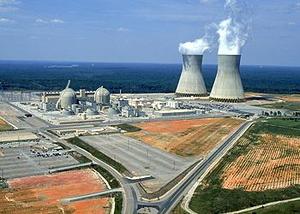Nuclear powerGeorgia’s Plant Vogtle may determine future of nuclear energy
Analysts say that the future of the U.S. nuclear industry, and of nuclear power generation in the United States, will largely depend on the success of two reactors, called Vogtle 3 and 4, at the Alvin Vogtle nuclear power plant in Georgia. For the nuclear industry, the Plant Vogtle project and another project in South Carolina may be the last hope of what many analysts consider to be a dying energy source.

The Alvin Vogtle nuclear plant outside of Atlanta // Source: mit.edu
Analysts say that the future of the U.S. nuclear industry, and of nuclear power generation in the United States, will largely depend on the success of two reactors, called Vogtle 3 and 4, at the Alvin Vogtle nuclear power plant in Georgia.
The New York Times reports that the twin reactors are among the largest construction projects in the United States, and that nuclear industry is making a bet that the $14 billion price tag will be cheaper than alternative forms of energy.
In an effort to show nuclear energy can be operated safely, Plant Vogtle is using a new plant design and construction method for what the industry believes is a faster, better, and cheaper nuclear power generation system.
Plant Vogtle’s first two reactors, which were built in 1987 and 1989, ended up costing $8.87 billion, much more than the original proposal, which estimated the cost to be just $660 million.
For the nuclear industry, Plant Vogtle project and another project in South Carolina may be the last hope of what many analysts consider to be a dying energy source.
“Everybody’s watching the construction of that plant,” Barry Moline, executive director of the Florida Municipal Electric Association, told the Times. Several association members are considering investing in a nearly identical plant proposed by Florida Power and Light in Miami. Moline referred to Vogtle’s builders, led by Georgia Power, saying: “If they can do it that will be the model.”
The new design is supposed to be ten times less likely to have an accident and be easier to operate, but there are concerns about the plant being built on schedule and on budget. If this does not happen, the nuclear energy industry may well suffer a decisive blow as natural gas and other alternative energies drop in price as they become more available.
Mark Cooper, an economic analyst affiliated with the Vermont Law School Institute for Energy and the Environment, predicted in a study in March that over their lifetimes, Vogtle 3 and 4 would cost $10 billion more than the alternatives.
Executives at Southern Company are welcoming the challenge.
“It takes leadership to do something like this,” Joseph Miller, Southern’s vice president for nuclear development told the Times.
The plan, however, has already suffered setbacks, and the schedule has slipped by fourteen months, which could prove costly. The company building the parts to be shipped to the site sent some of the parts with missing pieces or without paperwork. In addition, the shipments stopped altogether last August, and although they have been restarted since, they are coming at a slow pace.
Another issue is the basement of the plant. Contractors wove 1,200 tons of steel reinforcing bars together, but it was discovered the bars were connected differently from the original plans. The result was another delay, this time of seven and a half month, while a license amendment was being resolved.
According to William Jacobs, a longtime nuclear engineer hired by the Georgia Public Service Commission to monitor the construction, the delays could add hundreds of millions of dollars to the final cost.
The project can still be successful, as interest rates are at historic lows and the costs for labor and materials have been kept down by the recession.
